Placemaking is the process of proactively managing a place to make it better. When placemaking is done well, it leads to vibrancy of a place. It also creates more delightful destinations for all and is especially meaningful when created and shaped by communities who use the space.
Having led many placemaking efforts over the years, what does placemaking mean to you?
Jia-Ping: At its simplest form, placemaking is about ensuring that places are welcoming and inclusive for people from all walks of life.
When you go to a place that is empty, a placemaker will ask, what is around the area? What kind of communities are around? How can the place fulfil their needs? If the place has children, then perhaps we need a more child-friendly or a family-centric place.
Placemaking is ultimately a long-term strategy on how a place can be maximised. A place can only be maximised if you create one that resonates with the communities around it.

An example of an inclusive and welcoming place – the Marina Barrage open space lawn is a perfect spot for locals and tourists to enjoy a picnic and kite flying while taking in the views of the beautiful Singapore city skyline. Image credit: Tan Si Wei
You have been working with communities to rejuvenate places such as the heritage core in Kuala Lumpur and George Town in Penang. How can we get the community to be more interested in shaping places around them?
Jia-Ping: It is a delicate balance of giving communities what they want and having the knowledge that sometimes what they want may not be in the best interest for the area.
We need to be more open for individuals and communities to experiment with new ideas and different possibilities. Sometimes, the Asian culture is very failure or risk averse. It’s just like being a parent, you must allow your child to fail or let your child explore and give him or her the opportunity to succeed or fail. If they succeed, then cheer them on.
If they fail, then nurture and support them. Work with them to try the next iteration. The best placemaking effort is not just about doing one thing and then it is done. You must keep at it, allowing for things to fail, or ask, is it working? If it is, then how can we do it better.
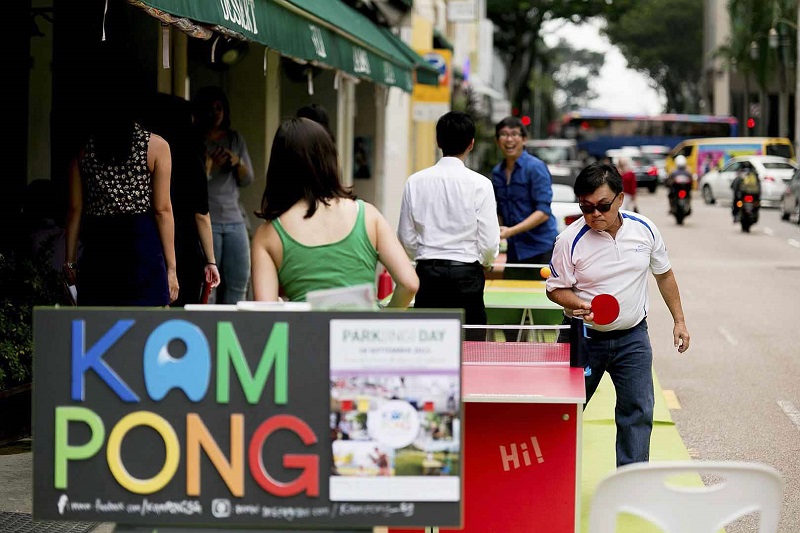
An example of experimenting with activating public spaces – under the KamPONG initiative, Singapore firm, Innoverde, placed ping pong tables in various public spaces to celebrate the kampung spirit.
As the former Programme Director at Think City, an urban rejuvenation group, you led the grants programme that supported many community efforts. How can we build active communities who are able to lead placemaking efforts?
Jia-Ping: At the basic level, we need to ask the community what they want for the place. Perhaps 10 per cent of what they want is what the place needs and you try to honour these needs. As placemakers, we then try and bring in additional ideas and some funding to add to this 10 per cent.
Placemaking is not about organising an event twice a year. Sometimes, we can be too retail-oriented where everything needs to be paid for. If we want the community to take charge, we must show them that not everything is about money. It is about investing time and commitment.
We need to also look out for the right people who can carry through the ideas. When we provide micro grants to support ideas that could enhance places, it is not just about supporting a good idea. We are also assessing the person who will lead and implement the ideas. What type of grantee are they? Are they open to accept critique and feedback? If they can’t take feedback or critique back or are not willing to make revisions to their proposals, then they naturally disqualify themselves from receiving the grant.
Even if a good idea is raised, I would ask, are you connecting to the right community? Can I introduce you to these people? We don’t just want to focus on just one idea or a one-time grant application. The bigger picture is that we are also connecting people to work together with one another, which can be cross-generational, like having youths work with seniors in the area.
Indeed, it takes a community of people to make things happen.
Jia-Ping: This reminds me of Lorong Yap Ah Loy, one of the laneways in the historic core of Kuala Lumpur that was revitalised when I was in Think City.
We came to know of a community of volunteers who wanted to plant some flowers and vegetables fronting two restaurants. We found a senior resident in the area who agreed to water the plants.
Kuala Lumpur City Hall (DBKL), which was a partner with Think City, decided to take this further by building a lovely shade awning that extends next to the planters so that people could sit under the awning. We also painted the wall behind the planters and that created a more memorable experience of this small enclave. Through these and other efforts, Lorong Yap Ah Loy has become a tourist attraction and a place that people like to be at.
You need to encourage people to start things in the city, and people will come to support and take it further, or you find the right people who can lead and sustain the ideas and then someone else will build it.
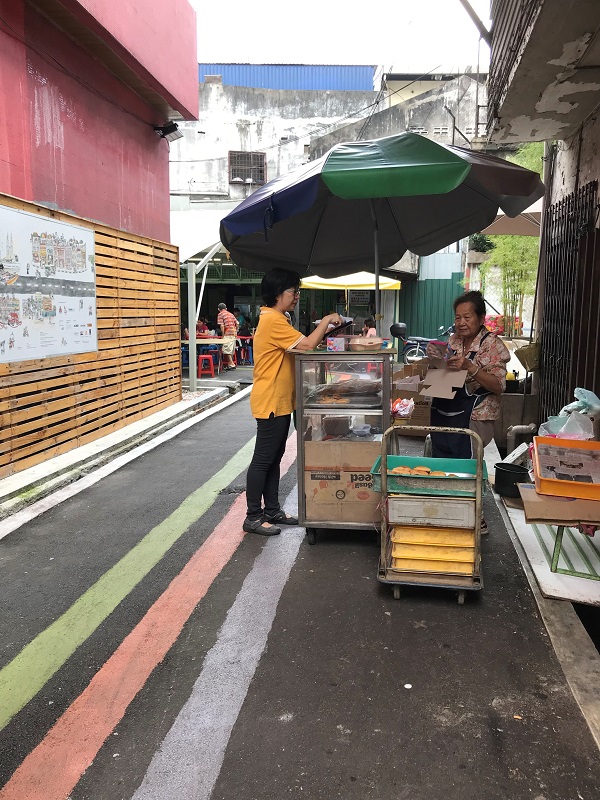
Lorong Yap Ah Loy, Kuala Lumpur. Image credit: Lee Jia-Ping
So, what are some possible benefits and impacts of placemaking?
Jia-Ping: Kebun Kebun Bangsar, an urban community farm is a good example to illustrate the impact of placemaking. It is both a park and farm in the city. It has flowers, vegetables and is home to live animals. The entire farm was developed under a stretch of electricity pylons (or transmission towers).
It became self-sustaining in three years through donations from people who visit. Many of their harvests are given away to orphanages, the refugee community and others. They also teach children how to plant. It was adopted by DBKL as a park and the project is a Think City grantee.
If you go in the morning, you can see someone in a wheelchair sitting under the tree. I met a lady with dementia who comes to this place to just sit and have her moment of peace. Children come here to play with the animals. The reason why this place works is because they have a very core committed group of volunteers, with a strong leader.
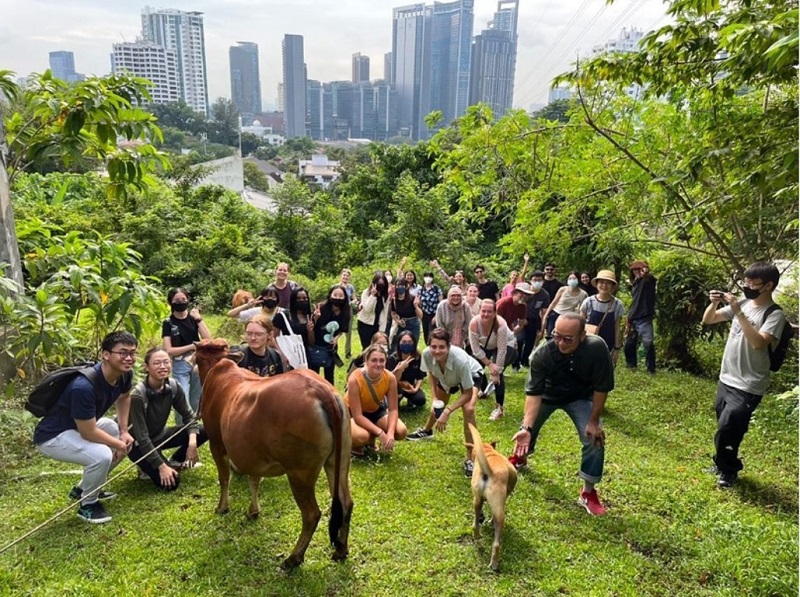
Students visiting Kebun Kebun Bangsar, a unique park and farm in the city. Image credit: Kebun Kebun Bangsar
How can we measure the impact of placemaking?
Jia-Ping: Not everything that is measured is good. Or you don’t need to measure everything. In an intangible way, having experienced many lockdowns during the pandemic, just the ability to go to a park, to be able to breathe the air outside is invaluable. But how do you measure that?
While quantitative data will tell you what is going on or not going on, it does not tell you the intangible qualities of the area. If you want to look at the long-term value of placemaking, you need to look at qualitative data.
Data can be useful as a guide to determine what to focus on for a place. For example, based on the census data, you know there is a senior community in the area. But if you don’t see any seniors using the spaces around the area or if they have nowhere to go to, then you need to ask why and address it. Based on data and speaking to the community, you can establish what is needed for the area.
There are various models of placemaking including the Business Improvement District (BID)1, a more formal approach for stakeholders to work together, which was piloted in Singapore in 2017. How can we make BID work well? How can we build trust amongst diverse stakeholders?
Jia-Ping: The BID approach works well when there is a strong community spirit amongst the stakeholders driving the placemaking efforts. It works if people understand that you need to have a long-term investment in the software aspects which can also help their bottom line.
It can be as simple as placing seats and tables outside buildings. Coffee shops sells more because of the seats. This benefits not just the small businesses but the larger ones.
When you have diverse stakeholders coming together, you need to identify the top three to five most important common values that everyone can commit to before even starting any plans.
To draw a parallel, a set of common values holds families together and the lack of it can break them down. It is also about having a clear understanding of balancing larger community objectives and the bottom line.
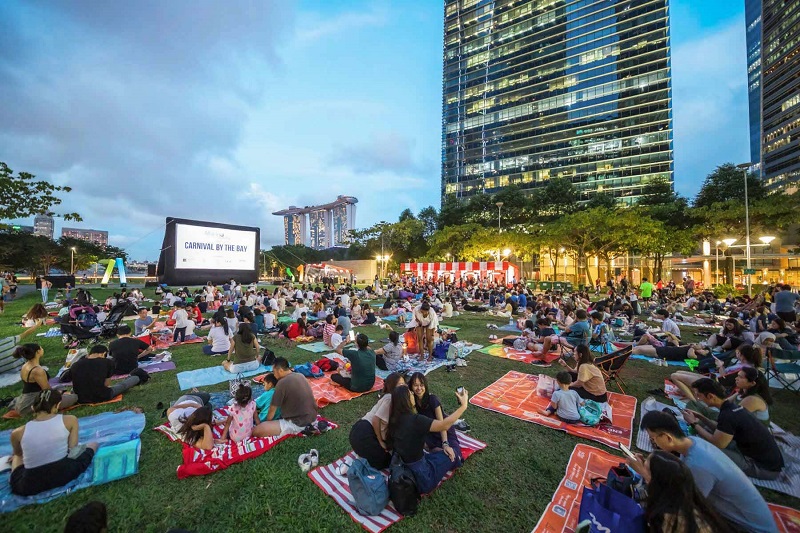
Marina Bay is one of the precincts under the pilot BID programme in Singapore, led by placemaking organisation, Marina Bay Alliance. An example of one of their activities is this two-day carnival and movie screening held at The Lawn in September 2022, to enhance the vibrancy in the precinct. Image credit: Marina Bay Alliance
How has the pandemic influenced placemaking?
Jia-Ping: The pandemic has reinforced the significance of placemaking efforts in shaping spaces around us. Beyond our obsession with running our businesses and making money, the pandemic has shown us the value of living, life, and relationships.
Where do you create synergies for life and relationships, for people to come together? These are the places that we are trying to activate and shape over time through placemaking – places to date, places to meet your parents, places for children to play, places to heal.
What is one major challenge for placemaking and what do you hope to see more of?
Jia-Ping: The biggest challenge is perhaps the term placemaking itself. This name has often been used by multiple parties to mean events or short-term programmes.
For us in the placemaking community, we firmly believe that placemakers should be brought into any project at the strategy development or master planning phases. This will ensure that desired outcomes for places can be better achieved. This includes economic vibrancy, increased sense of belonging from both businesses and resident stakeholders, as well as more proactive ground-up ownership by communities.
To give an example, it is very inspiring to see the work of the Milan Municipal Council in progressively converting street spaces into mini public spaces or plazas. It started with simple interventions for three spaces, and it has now grown to converting over 30 spaces into community parks and people-places. They embraced the philosophy of tactical urbanism to trial the interventions before making them permanent.
This is what I hope to see more of in cities – adopting quicker, lighter and cheaper solutions to create memorable places designed to meet the needs of the local community.
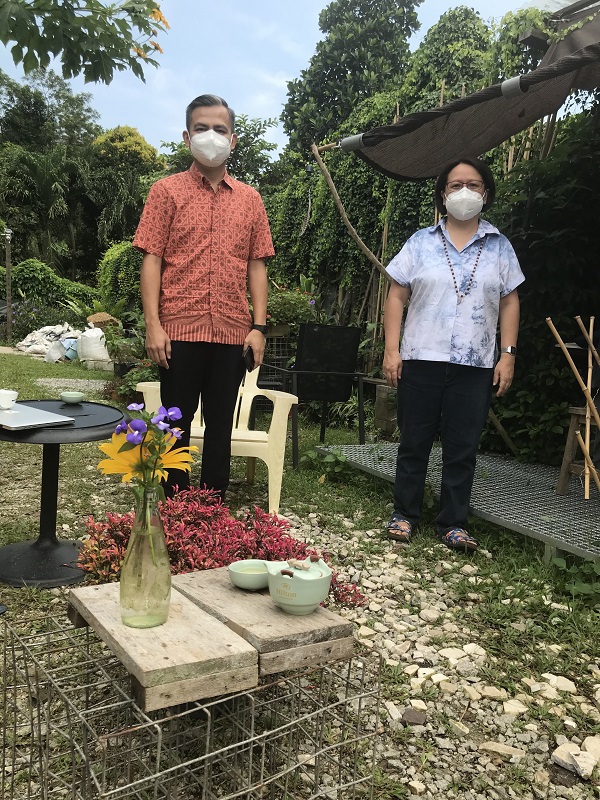
Lee Jia-Ping (as Chairperson, Placemaking Malaysia), with Member of Parliament, YB Fahmi Fadzil. Image credit: Lee Jia-Ping
About Lee Jia-Ping
Lee Jia-Ping is the founder of Pollin8, a place consultancy. She has incorporated her experiences in theatre, the arts, branding, and place strategy to rejuvenate urban and corporate places as well as hospitals. As the former Programme Director at Think City, a government-linked urban rejuvenation group, she drove the rejuvenation of the heritage core of Kuala Lumpur and introduced an entrepreneur matching grant to the Think City Grants Programme. Her role in Think City saw her growing the placemaking movement in the region, culminating in the first Placemaker Week ASEAN in 2019. In 2020, she was made Start Up Board member of PlacemakingX, a global network for placemaking leaders.
____
1 With growing interest in placemaking and the need for long term sustainability for key precincts, the pilot Business Improvement District (BID) programme was introduced in Singapore from 2017, to determine the feasibility of implementing a formalised BID model in future. So far, 10 precincts have expressed interest to form pilot BIDs, with the first forming in 2017 and four others forming between 2019 and 2020.


